 Open Access
Open Access
ARTICLE
Efficient DP-FL: Efficient Differential Privacy Federated Learning Based on Early Stopping Mechanism
1 College of Automation and Information Engineering, Sichuan University of Science and Engineering, Yibin, 644000, China
2 Sanjiang Research Institute of Artificial Intelligence and Robotics, Yibin University, Yibin, 644000, China
3 Science and Technology on Communication Security Laboratory, China Electronics Technology Corporation 30th Research Institute, Chengdu, 610041, China
* Corresponding Author: Lecai Cai. Email:
(This article belongs to the Special Issue: Security and Privacy Challenges in Smart City)
Computer Systems Science and Engineering 2024, 48(1), 247-265. https://doi.org/10.32604/csse.2023.040194
Received 08 March 2023; Accepted 27 April 2023; Issue published 26 January 2024
Abstract
Federated learning is a distributed machine learning framework that solves data security and data island problems faced by artificial intelligence. However, federated learning frameworks are not always secure, and attackers can attack customer privacy information by analyzing parameters in the training process of federated learning models. To solve the problems of data security and availability during federated learning training, this paper proposes an Efficient Differential Privacy Federated Learning Algorithm based on early stopping mechanism (Efficient DP-FL). This method inherits the advantages of differential privacy and federated learning and improves the performance of model training while protecting the parameter information uploaded by the client during the training process. Specifically, in the federated learning framework, this article uses an adaptive DP-FL method for gradient descent training, which makes the model converge faster than traditional stochastic gradient descent. In addition, due to model convergence, noise should be reduced accordingly. This paper introduces an early stopping mechanism to improve data availability. This paper demonstrates the performance improvement of the Efficient DP-FL algorithm through simulation experiments on real MNIST and Fashion-MNIST datasets. Experimental show that the efficient DP-FL algorithm is significantly superior to other algorithms.Keywords
In recent years, with the rapid development of machine learning technology, smart devices have generated massive amounts of data. Machine learning [1–5] techniques are widely used to process these data. However, centralized machine learning requires enormous computing power and attracts centralized attacks. To save computing power and ensure the confidentiality of the client’s local private data, a feasible solution is to put the client’s locally trained model into the federated learning framework for processing. Since federated learning trains data locally and does not upload private data, the privacy overhead of the client is effectively reduced. Therefore, federated learning is widely used in the Industrial Internet of Things [6–10], Blockchain [11–15], and Smart Healthcare [16–18].
Although federated learning can effectively prevent the leakage of users’ local private data, adversaries can still attack the model by analyzing the parameters of the local federated learning model [19–25]. Therefore, ensuring the privacy and security of users’ local data is a challenge.
To address this issue, DP is widely used for privacy protection in deep learning [26–29]. For example, Abadi et al. [30] proposed to use DP for deep learning and developed a new differential privacy stochastic gradient descent (DP-SGD) algorithm. Lee et al. [31] improved upon DP-SGD and allocate a privacy budget in each training session. Recently, DP has also been used in federated learning scenarios [32–35]. For example, Wei et al. [32] proposed to use DP for federated learning and proposed a new framework (NbAFL) based on differential privacy federated learning by adding Gaussian noise before the parameter aggregation of the client model. Xu et al. [33] proposed an Adaptive Fast Convergent Learning Algorithm (ADADP) with a provable privacy budget, when the client participates in model training, the model can show good training performance at a fixed privacy level. Truex et al. [34] proposed a hybrid approach based on DP and Secure Multi-Party Computation (SMC) to prevent inference attacks and generate the better models. However, this also consumes more communication resources. Therefore, it is necessary to design a more efficient differential privacy federated learning algorithm.
To address these challenges, this article proposes an efficient differential privacy federated learning method based on an early stopping mechanism. To summarize, our contributions to this paper focus on three points:
• An Efficient DP-FL algorithm was proposed. Specifically, the algorithm inherits the advantages of differential privacy and federated learning and protects the actual parameters uploaded by the client during the training process.
• The Efficient DP-FL algorithm adds an early stopping mechanism to reduces unnecessary noise and improve the availability of the data.
• The efficiency of the proposed method is shown through theoretical analysis and simulation experiments.
The rest of this paper is organized as follows. In Section 2, some initial preparations for our algorithm are provided. Section 3 proposes an efficient differential privacy federated learning scheme based on an early stopping mechanism, and Section 4 conducts privacy analysis. Experiments is in Section 5. Section 6 gives the conclusion. The basic concepts and meanings of the symbols are summarized in Table 1.

Let us observe the system of FL consisting of N clients and an aggregation server, as shown in Fig. 1. Di represents the dataset of the local client Ui, i∈{1,2,⋯,N}. The task of the aggregation server is to train the model from the relevant parameter information of the local clients. The training of the local client aims to find the optimal vector w of the model to minimize some loss function. In general form, the weight that the server aggregate receives from N local clients is as follows:
w=∑Ni=1piwi(1)
where w is the parameter vector aggregated by the server, wi is the parameter vector trained on the i-th client, and N is the number of all clients. pi=|Di||D|≥0, ∑Ni=1pi=1, |D|=∑Ni=1|Di| is the total number of all datasets, Di is the dataset of the i-th local client. Fi(.) is the loss function of the i-th local client, The optimization task of federated learning can be expressed as:
w∗=argminw∑Ni=1piFi(Di,w)(2)
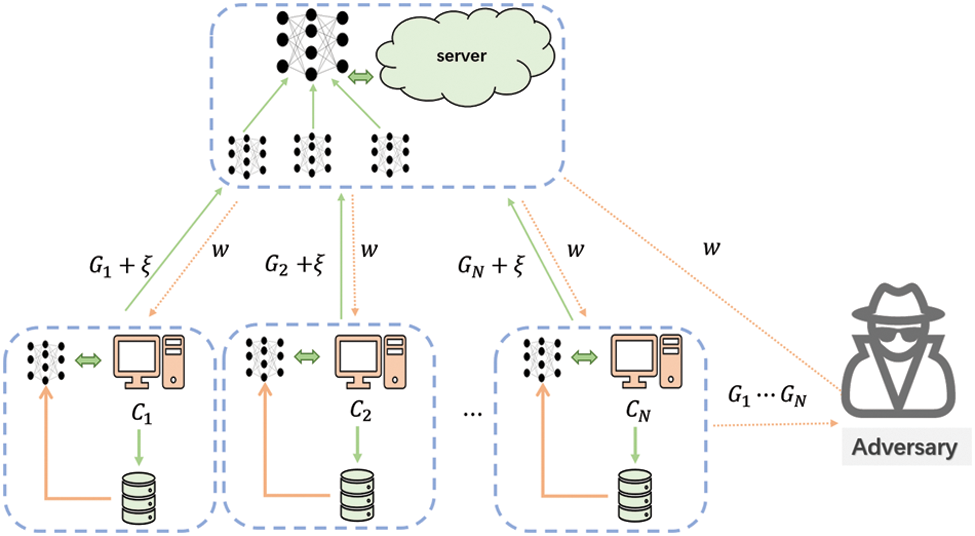
Figure 1: A differential privacy federated learning training model with the hidden adversary
The steps of each round of the training process of the federated learning general system are as follows:
• Local training: All local clients use local samples to update the model based on the original data, and send the locally trained model parameters to the aggregation server.
• Model aggregation: The server aggregates and averages the parameters uploaded by each local client and updates the global model.
• Parameters broadcasting: The aggregation server broadcasts the updated the current parameters to each local client.
• Model updating: Each local client updates the local model with the latest parameters received and tests the performance of the current model.
In this paper, the server is assumed to be honest but curious. Although the single dataset of the i-th client is stored locally in FL, the parameter wi needs to be shared with the aggregation server, which may disclose the client’s private. Therefore, semi-honest models are vulnerable to member inference attacks and attribute inference attack. Specifically, an adversary can perform attribute inference attacks by extracting training data during model training or by extracting feature vectors of training data [36–40]. For example, Salem et al. [41] proposed a hybrid generative model, which assumes that the adversary has black-box access to the model and has specific samples as prior knowledge, the adversary can judge whether the training set of the model contains feature samples, and thus initiate Membership inference attack. Lacharité et al. [42] proposed an approximate attribute inference attack, which is a method to enable range queries when the model provides little security. To sum up, the adversary may launch inference attacks based on the parameter information obtained during model training. Therefore, the threat model presented in this article is reasonable.
In recent years, DP has become a standard concept for federated learning privacy protection and has been widely used in federated learning data analysis tasks.
Definition 1: (ε,δ)−DP: A randomized algorithm ℳ:χ→ℛ with domain χ and range ℛ satisfies (ε,δ)−DP if for any two adjacent datasets 𝓶,𝓷∈χ and for all measurable sets 𝒪∈ℛ, it holds that
Pr[ℳ(𝓶)∈𝒪]≤eεPr[ℳ(𝓷)∈𝒪]+δ(3)
A Gaussian mechanism defined in [33] can be used to guarantee (ε,δ)−DP.
To reduce privacy costs and improve the model convergence rate, Efficient DP-FL uses an adaptive learning rate for the gradient descent training model. In addition, Efficient DP-FL adds Gaussian noise to the gradient, and the gradient performs adaptive noise processing according to the adaptive learning rate, thereby improving the performance of model training. To further mitigate the impact of noise on model performance, the algorithm introduces an early stopping mechanism. The following will introduce the Efficient DP-FL method and give its differential privacy guarantee.
The gradient descent method is commonly used to train deep learning models. The goal of training the model is to obtain the smallest loss function value. To minimize the local loss function, usually a subset of the data is randomly selected and the parameter wt+1←wt−α∇wtFi (xi,wt). The learning rate determines the step of the gradient descent update. If the learning rate is too large, it will fall into the dilemma of the local optimal solution. If the learning rate is too small, it will take a long time to obtain the optimal solution. Therefore, how to set an appropriate learning rate to avoid falling into a local optimal solution is a challenge we face. Relevant scholars have proposed more advanced optimizers, such as Adadelta, Adagrad, RMSProp, etc., to solve the above problems, and they update parameters by adaptively adjusting the learning rate.
Efficient DP-FL uses an approach similar to adaptive gradient descent with the Adam optimizer. The framework proposed in this paper is not only suitable for other types of gradient descent, but also for adaptive gradient descent with added noise.
Theorem 1: For any ε∈(0,1), c2>2ln(1.25/δ), the Gaussian Mechanism parameter σ≥cΔf/ε is (ε,δ)−DP.
To ensure that the Gaussian noise distribution ξ∼N (0,σ2) satisfies (ε,δ)−DP, Dwork et al. [43] choosed the noise range σ≥cΔf/ε and the c≥√2ln(1.25/δ), here N denotes the noise distribution, ε∈(0,1) denotes the additive noise value of a particular data in the dataset, Δf is the sensitivity,
Proof. There is a dataset
To study the different probability of adjacent dataset
Furthermore, looking at the absolute value.
whenever
assume that
Taking
Let us write
when
Due to
In order words, it needs that
which, since
Let
yielding
Lemma 1:
Based on the proof of Theorem 1. we have the Gaussian noise distribution in this paper is subject to
Namely,
Considering the above differential privacy mechanism, the noise scope affects the privacy cost of the client and the convergence speed of the federated learning training process. Therefore, choosing the appropriate noise level remains a significant research problem. In this paper, the distribution of adding Gaussian noise to the gradient obeys the normal distribution
The early stopping mechanism its commonly used regularization technique in deep neural networks, and its performance is usually better than general regularization methods. Its popularity is mainly due to its effectiveness and simplicity. The model stores and updates the current best parameters during training. When the error on the validation set does not improve further within a pre-specified number of iterations, the algorithm terminates and uses the last best parameters. This process is more formally described in Algorithm 1.
When training large models with sufficient representational power to the point of overfitting, we often observe that the training error gradually decreases over time but the validation error rises again. The early stopping mechanism is mainly a trade-off between training time and generalization error. It reduces communication overhead while obtaining optimal parameters. And because the algorithm reduces the number of communications, thereby also reducing the noise, the introduction of the early stopping mechanism improves the utility of the data.
3.3 Efficient DP-FL and Main Results
To protect the safety of parameters during federated learning training, it can be considered to add Gaussian noise to each sample gradient. However, adding too much Gaussian noise to the parameters can destroy the performance of the model. Therefore, we need to control the impact of parameter training on model performance during federated learning training. This approach has been extensively studied in previous work [30,33,44], and we make some modifications, especially about the privacy budget. Its training process is shown in Algorithm 2.
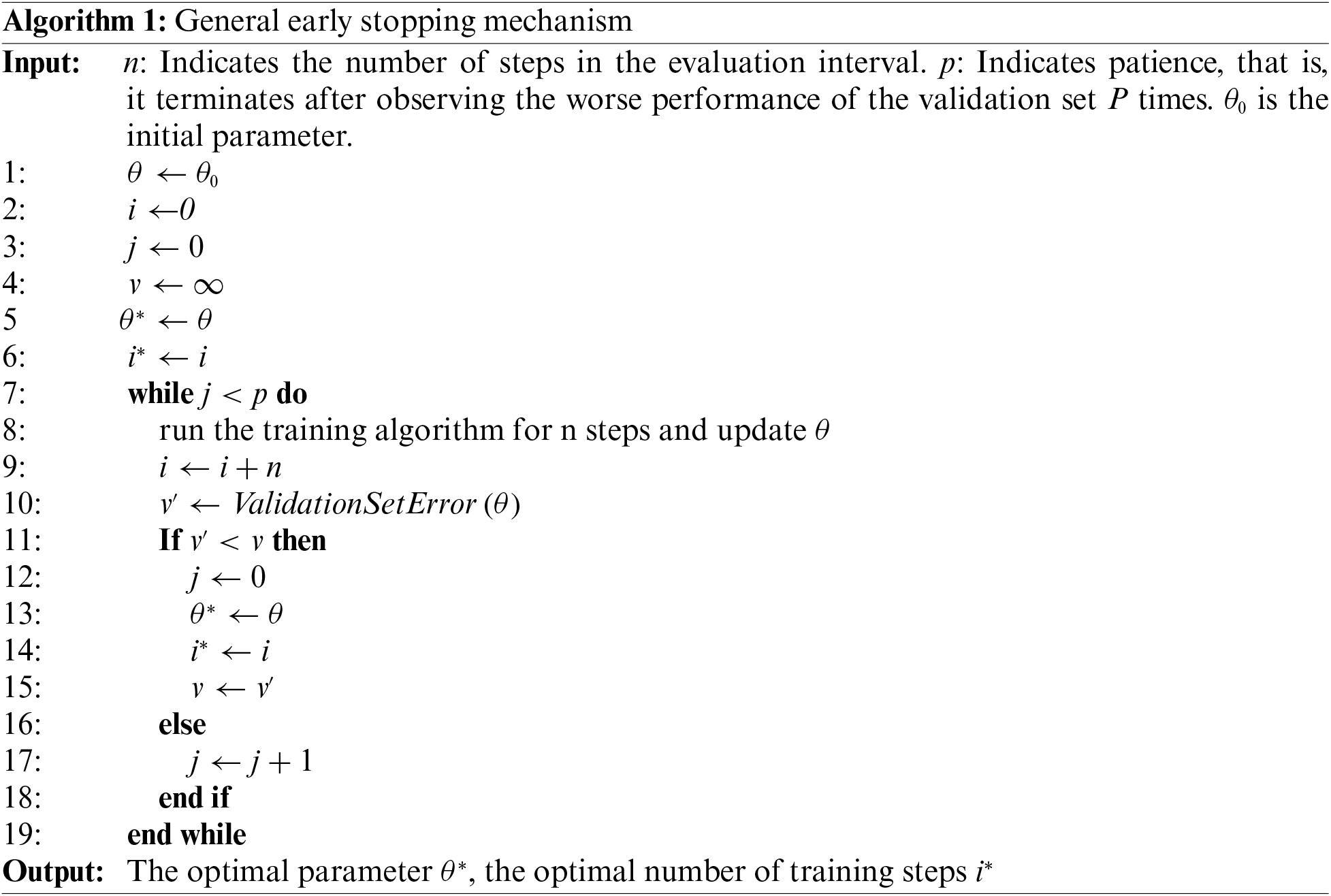
Many researchers have studied the loss of privacy under specific noise. For example, Beimel et al. [45] proposed a privacy amplification theorem, where
Definition 2: At s,
The moment mother function of the privacy loss random variable is:
Definition 3:
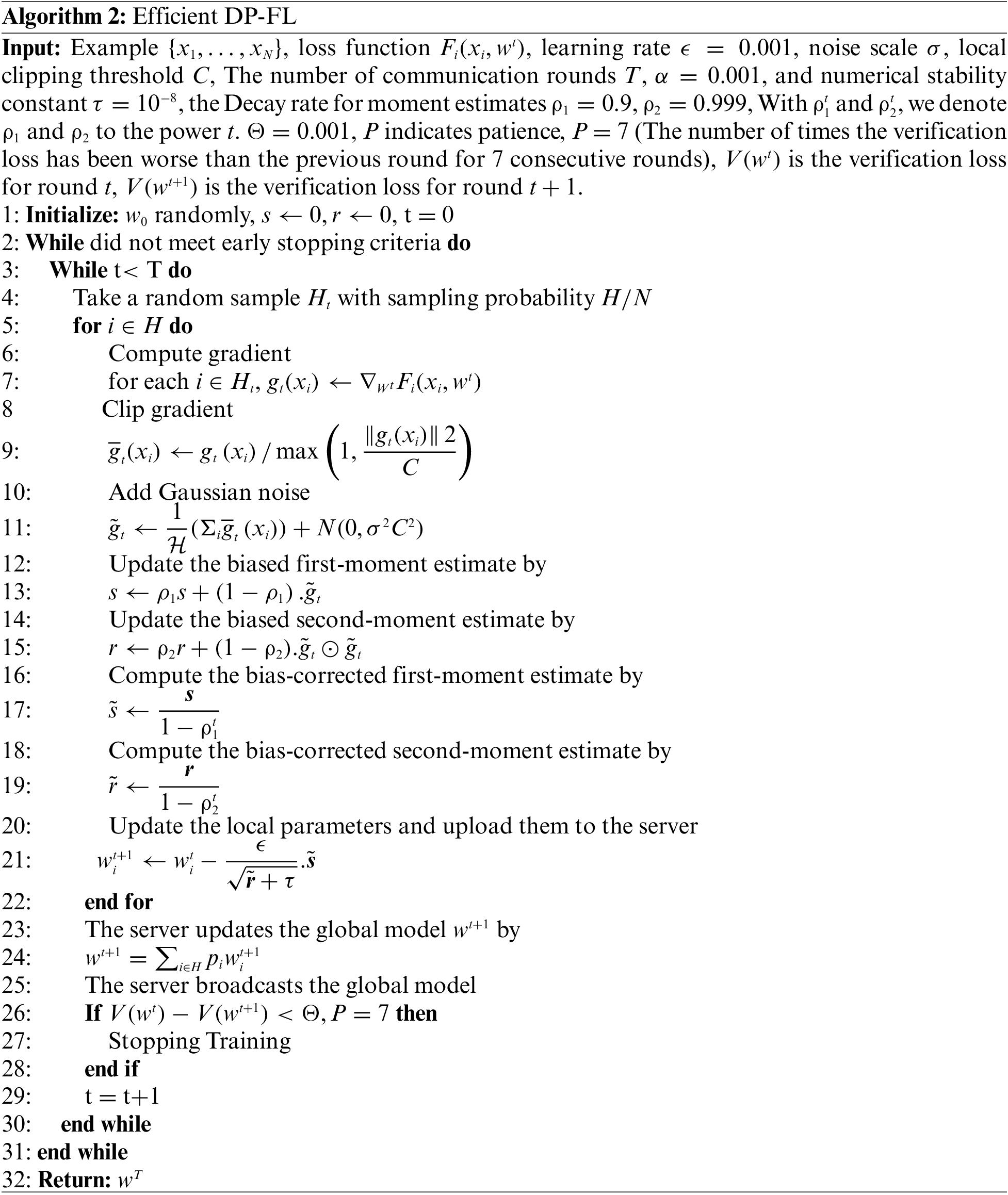
Definition 4:
Theorem 2: Let
According to Definitions 2, 3 and 4, we can prove Theorem 2, the proof is as follows:
Proof. We have
(Markov’s):
So, for any
In each training iteration, the entire dataset satisfies
5 Experimental Results and Comparison
This section conducted extensive comparative experiments on the MNIST and the Fashion-MNIST datasets to evaluate the performance of the proposed Efficient DP-FL scheme. As a baseline for comparison, we choose to compare with the state-of-the-art research scheme [30,33,44]. Finally, the experiment is completed under the NVIDIA GeForce RTX 2080TI GPU (64 GB RAM) and Windows 10 system, and the model training is conducted under the PyTorch framework. Experiments have shown that the Efficient DP-FL method is better than previous research methods.
Experimental settings: The experiment uses the MNIST handwritten digit recognition and the Fashion-MNIST clothing classification dataset. Both datasets consist of 70000 sheets 28 × 28 grayscale image, all of which are divided into 10 categories, with 60000 samples used for training and 10000 samples used for testing. This paper uses a shallow CNN, which consists of two convolutional layers and two fully connected layers. Convolutional Layer Use 5 × 5 convolutions with stride 1. The first convolution outputs 12 for each image 6 × 6 × 64 tensors, second convolution for each image output 6 × 6 × 64 tensors. Then ReLU and 2 × 2 maximum pooling layers flatten the second convolution layer into a vector that is fed to a fully connected layer with 384 units. This article divided the training data from 10 clients into non-IID segments based on digital tags and divided into an average of 400 segments. Each customer is assigned 40 random data segments, so each customer’s sample has two or five tags. Each round of experiments is set at 1000 epochs. We use a fixed value
5.1.1 Model Performance for Adaptive DP-FL Method on MNIST and Fashion-MNIST Datasets
Fig. 2 investigates the effect of Adaptive DP-FL’s approach on model performance. The accuracy and loss of the Adaptive DP-FL method and the method without ADADP are compared. We set clipping threshold

Figure 2: Model performance for adaptive DP-FL method on MNIST and fashion-MNIST datasets
5.1.2 Performance Comparison of Algorithms under Different Noise Scales
As a multi-party collaborative training model method, federated learning its local private data for model training. The data is saved locally on the client and the trained local model is updated to the server, which aggregates the local model. However, federated learning has a natural privacy protection effect. An attacker can still infer local private data through the model parameters of the client or server. Therefore, we introduce a differential privacy technology lighter than the cryptographic method. However, the introduction of differential privacy usually seriously affects the utility of data while protecting data privacy security. To solve this problem, this article proposes a secure and efficient DP-FL scheme. During each update process of the model, add the Gaussian noise to the sample gradient in the differential privacy technology and then iteratively update by an adaptive algorithm. The scheme strengthens the privacy security of the model and improves its performance. To test the robustness of the algorithm under different noise scales, this paper compared the performance of three different algorithms, DPFL-SGD, DPFL-PRMSProp, and the algorithm proposed in this paper under different noise conditions. In general, the larger the noise scale added, the lower the data availability and the worse the model performance.
As seen in Fig. 3, in each plot,
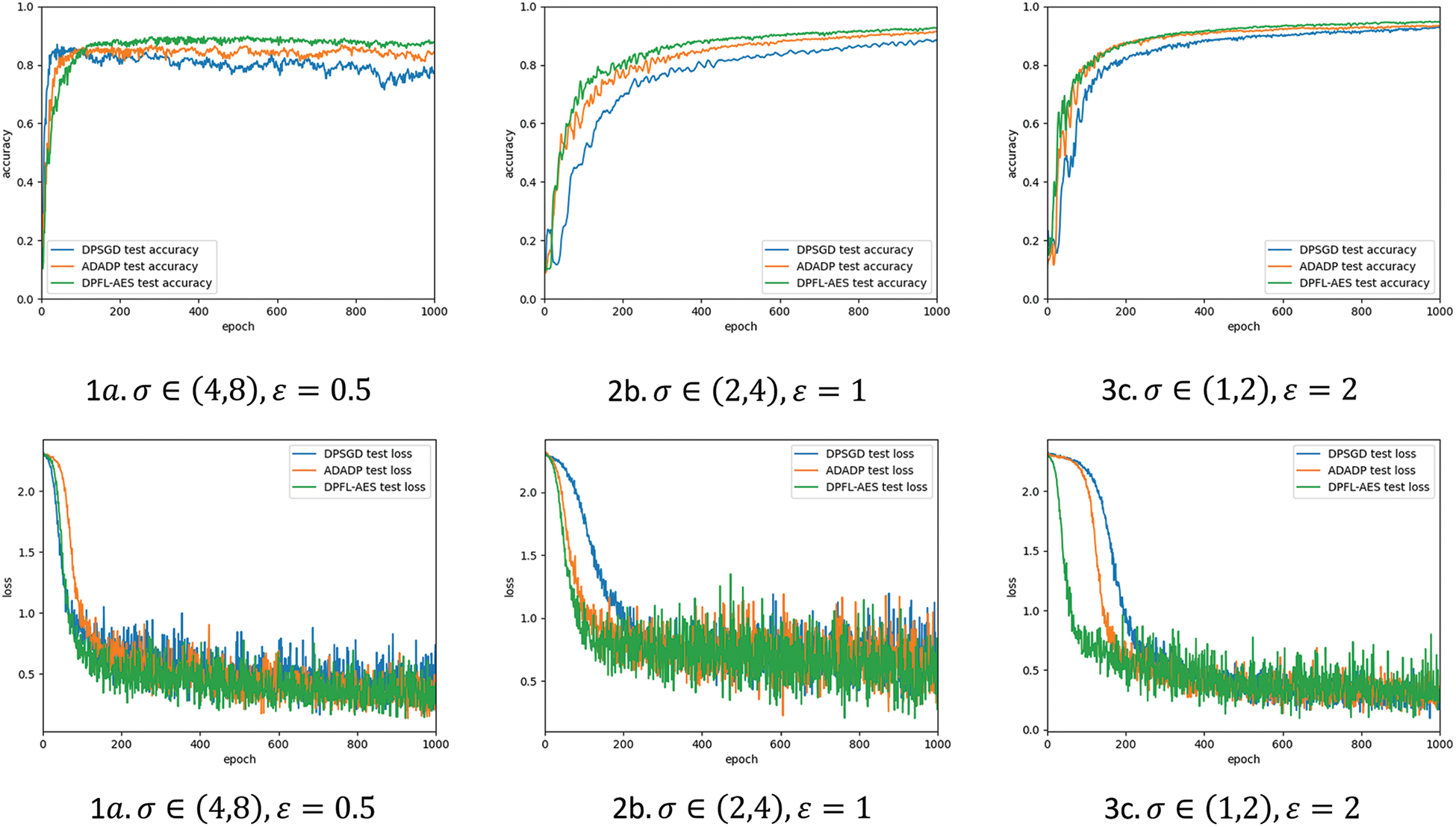
Figure 3: The effect of different noise scales on the convergence performance of the algorithm
The federated learning model with adaptive differential privacy is less sensitive to the size of the noise scale. Experiments show that with a fixed 1000 rounds of communication iterations, our algorithm has faster convergence speed and better final results. Our scheme can achieve better model performance with lower communication costs when applied to actual demand scenarios.
5.1.3 Model Performance for Early Stopping Mechanism on MNIST and Fashion-MNIST Datasets
It can be seen from Fig. 4 that after adding the early stopping mechanism, different algorithms converge in advance. On the MNIST dataset, ADADP converges early with 91.20% accuracy in 762 epochs. Compared with the fixed-setting 1000-round iteration experiment, it saves 238 rounds of communication overhead while achieving similar performance. Our algorithm converges ahead of time with 94.01% accuracy in 639 rounds, which saves 361 rounds of communication overhead while achieving similar performance. On the Fashion-MNIST dataset, ADADP converges early with 91.62% accuracy at 834 rounds. Compared with the fixed-set 1000-round iteration experiment, it saves 166 rounds of communication overhead while achieving similar performance. Our algorithm converges ahead of time with 94.93% accuracy in 785 rounds, which saves 215 rounds of communication overhead while achieving similar performance. At the same time, we can see that our algorithm outperforms previous methods. To sum up, the early stopping mechanism can reduce communication overhead while ensuring the convergence of the model. Therefore, compared to other methods, our algorithm is better able to improve data utility while keeping data safe.
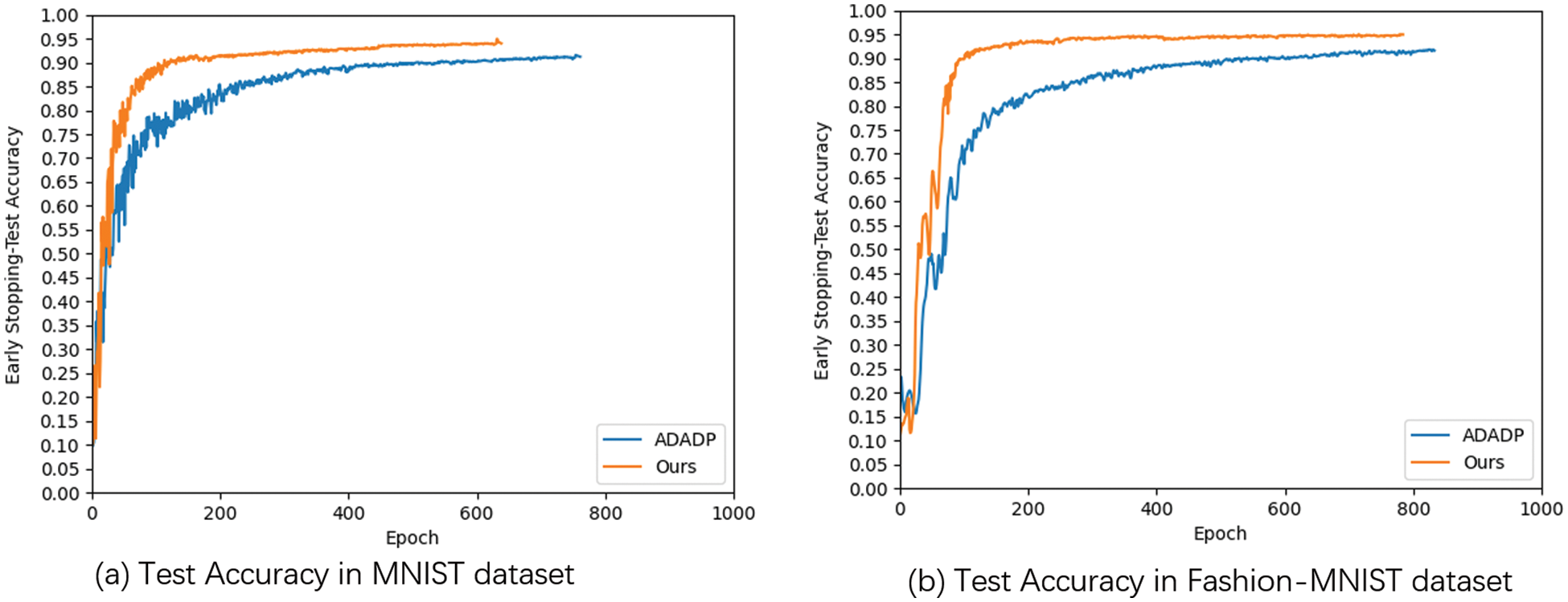
Figure 4: Performance for early stopping mechanism on MNIST and fashion-MNIST datasets
5.1.4 Model Performance for Efficient DP-FL Method on MNIST and Fashion-MNIST Datasets
Fig. 5 investigates the performance of the Efficient DP-FL method on the MNIST and the Fashion-MNIST datasets. The Efficient DP-FL method combines the effects of Adaptive DP-FL and Early Stopping mechanism on model performance. The accuracy and loss of differential privacy federated learning methods with adaptive Gaussian noise and constant noise without adaptation are compared. We set the same clipping threshold
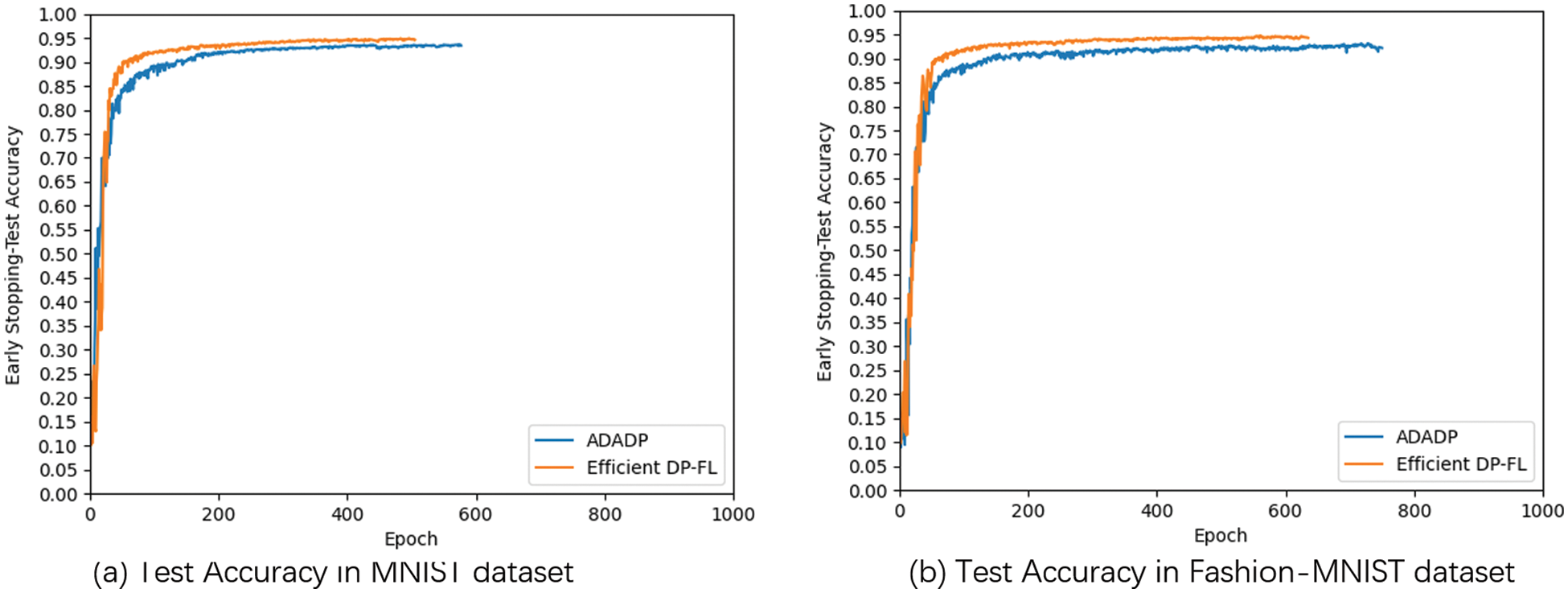
Figure 5: Performance for efficient DP-FL method on MNIST and fashion-MNIST datasets
Table 2 shows a comparison of the studied algorithms, including data security, data utility, adaptation, and communication cost. The above comparison shows that our algorithm can simultaneously satisfy data security, data utility, an adaptability and reduce communication overhead. In contrast, other algorithms do not have this capability. Specifically, reference [30] proposed a DPSGD algorithm for the first time, which uses a Gaussian down-sampling mechanism and uses moment calculation technology to measure privacy loss. Although this algorithm can effectively protect the data security of local clients, adding a large amount of noise to the algorithm will reduce the usefulness of the data, and the algorithm cannot adaptively reduce noise [33]. An ADADP algorithm was proposed, which adaptively adjusts the noise range under a given privacy level, enabling the algorithm to converge quickly [44]. A UDP algorithm with a CRD method are proposed. The UDP algorithm can effectively protect the data security of local users, and a UDP algorithm with a CRD method can effectively reduce the number of communication rounds. However, compared to the scheme proposed in this article, this algorithm cannot effectively improve the utilization rate of data, and the communication cost is not as low as the proposed scheme. However, compared with Efficient DP-FL algorithm, this algorithm cannot effectively improve the utility of data and reduce the communication cost-effectively. In summary, the Efficient DP-FL algorithm fully satisfies the advantages of data security, data utility, adaptability, and low communication overhead. The above is a qualitative analysis of different algorithms. The following will quantitatively analyze the communication costs of different schemes, as shown in Fig. 6. Quantitative comparative analysis has been added.

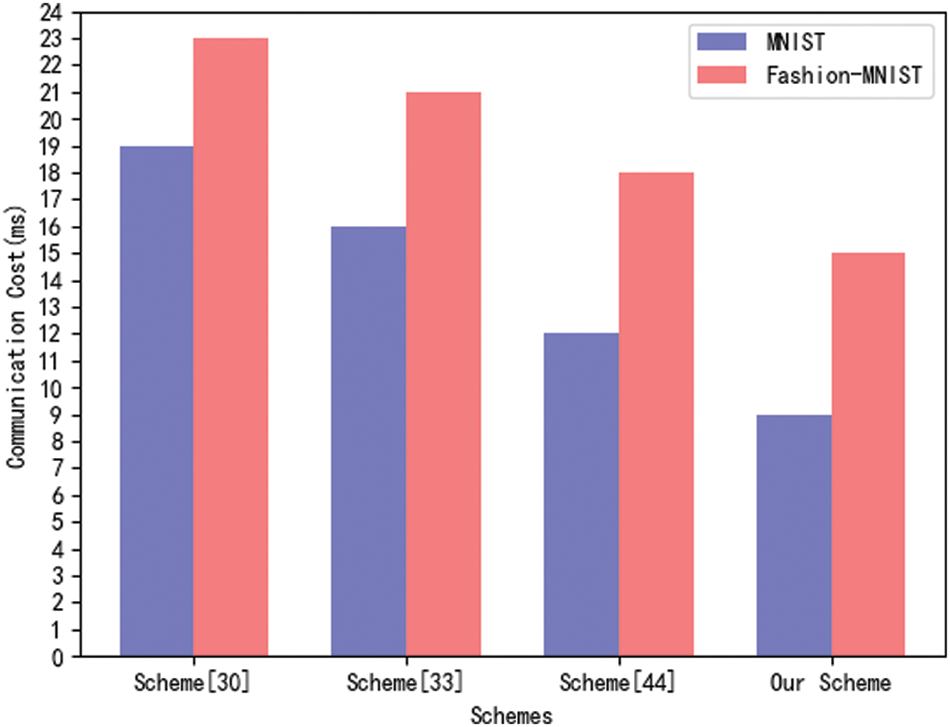
Figure 6: Communication cost comparison of different scheme
Fig. 6 compares the time cost of a round of communication for different schemes. The proposed scheme uses adaptive learning rates to adjust the gradient descent train process to avoid model overfitting and fluctuations, and uses an early shutdown system to reduce noise, ensuring that federated learning schemes train efficiently while protecting data security. The communication cost comparison results are shown in Fig. 6. Looking at Fig. 6, we can draw the following conclusions.
• The scheme [30] has the longest running time, while the schemes [33] and [44] have the lowest running time. The above comparison shows that the scheme proposed in this article is effective.
• Because Fashion MNIST is a set of 28 × 28 grayscale clothing images, its image data is more complex than MNIST, the four schemes on MNIST have shorter runtime than those on Fashion-MNIST.
The main contributions of this article are reflected in three aspects. Firstly, an Efficient DP-FL algorithm is proposed, which has higher accuracy than previous algorithms. In addition, the Efficient DP-FL algorithm adds an early stopping mechanism to improve the utility of the data. Secondly, it is strictly proved mathematically that the Efficient DP-FL algorithm satisfies differential privacy. Thirdly, the Efficient DP-FL algorithm is applied to train a CNN model on a deep learning network with real datasets, and the better performance of the Efficient DP-FL algorithm compared to previous methods is evaluated through experiments.
Based on the Efficient DP-FL proposed in this article, many further tasks deserve attention. In particular, this article uses a shallow neural network model, and the deeper neural network model is worth further research. In addition, you can apply the techniques in this article to language modeling tasks through experience in the MNIST and Fashion-MNIST.
Acknowledgement: The authors wish to express their appreciation to the reviewers for their helpful suggestions which greatly improved the presentation of this paper.
Funding Statement: This work was supported in part by the Communication Security Laboratory Science and Technology Fund under Grant No. 61421030209012105, in part by the Sichuan Provincial Science and Technology Department Project under Grant 2019YFN0104, in part by the Yibin Science and Technology Plan Project under Grant 2021GY008, and in part by the Sichuan University of Science and Engineering Postgraduate Innovation Fund Project under Grant Y2022154.
Author Contributions: Study conception and design: Sanxiu Jiao; data collection: Jintao Meng; analysis and interpretation of results: Sanxiu Jiao, Yue Zhao, Lecai Cai; draft manuscript preparation: Kui Cheng. All authors reviewed the results and approved the final version of the manuscript.
Availability of Data and Materials: All data are derived from public datasets.
Conflicts of Interest: The authors declare they have no conflicts of interest to report regarding the present study.
References
1. J. G. Greener, S. M. Kandathil, L. Moffat and D. T. Jones, “A guide to machine learning for biologists,” Nature Reviews Molecular Cell Biology, vol. 23, no. 1, pp. 40–55, 2022. [Google Scholar] [PubMed]
2. T. R. Ramesh, U. K. Lilhore, M. Poongodi, S. Simaiya, A. Kaur et al., “Predictive analysis of heart diseases with machine learning approaches,” Malaysian Journal of Computer Science, pp. 132–148, 2022. https://doi.org/10.22452/mjcs.sp2022no1.10 [Google Scholar] [CrossRef]
3. N. Ali, T. M. Ghazal, A. Ahmed, S. Abbas, M. A. Khan et al., “Fusion-based supply chain collaboration using machine learning techniques,” Intelligent Automation & Soft Computing, vol. 31, no. 3, pp. 1671–1687, 2022. [Google Scholar]
4. Y. Zhang, Z. Gao, X. Wang and Q. Liu, “Image representations of numerical simulations for training neural networks,” Computer Modeling in Engineering & Sciences, vol. 134, no. 2, pp. 1–13, 2022. [Google Scholar]
5. Y. Zhang, Z. Gao, X. Wang and Q. Liu, “Predicting the pore-pressure and temperature of fire-loaded concrete by a hybrid neural network,” International Journal of Computational Methods, vol. 19, no. 8, pp. 247, 2022. [Google Scholar]
6. Y. Liu, R. Zhao, J. Kang, A. Yassine and D. Niyato, “Communication-efficient and attack-resistant federated edge learning for Industrial Internet of Things,” ACM Transactions on Internet Technology, vol. 22, no. 3, pp. 1–22, 2021. [Google Scholar]
7. J. Chen, J. Xue, Y. Wang, L. Huang, T. Baker et al., “Privacy-preserving and traceable federated learning for data sharing in industrial IoT applications,” Expert Systems with Applications, vol. 213, pp. 119036, 2023. https://doi.org/10.1016/j.eswa.2022.119036 [Google Scholar] [CrossRef]
8. A. Imteaj, U. Thakker, S. Wang, J. Li and M. H. Amini, “A survey on federated learning for resource-constrained IoT devices,” IEEE Internet of Things Journal, vol. 9, no. 1, pp. 1–24, 2021. [Google Scholar]
9. D. C. Nguyen, M. Ding, P. N. Pathirana, A. Seneviratne, J. Li et al., “Federated learning for Internet of Things: A comprehensive survey,” IEEE Communications Surveys & Tutorials, vol. 23, no. 3, pp. 1622–1658, 2021. [Google Scholar]
10. T. Zhang, L. Gao, C. He, M. Zhang, B. Krishnamachari et al., “Federated learning for the internet of things: Applications, challenges, and opportunities,” IEEE Internet of Things Magazine, vol. 5, no. 1, pp. 24–29, 2022. [Google Scholar]
11. L. Ouyang, F. Y. Wang, Y. Tian, X. Jia, H. Qi et al., “Artificial identification: A novel privacy framework for federated learning based on blockchain,” IEEE Transactions on Computational Social Systems, pp. 1–10, 2023. https://doi.org/10.1109/TCSS.2022.3226861 [Google Scholar] [CrossRef]
12. A. Yazdinejad, A. Dehghantanha, R. M. Parizi, M. Hammoudeh, H. Karimipour et al., “Block hunter: Federated learning for cyber threat hunting in blockchain-based IIoT networks,” IEEE Transactions on Industrial Informatics, vol. 18, no. 11, pp. 8356–8366, 2022. [Google Scholar]
13. A. Islam, A. Al Amin and S. Y. Shin, “FBI: A federated learning-based blockchain-embedded data accumulation scheme using drones for internet of things,” IEEE Wireless Communications Letters, vol. 11, no. 5, pp. 972–976, 2022. [Google Scholar]
14. A. Lakhan, M. A. Mohammed, S. Kadry, S. Al-Qahtani, M. S. Maashi et al., “Federated learning-aware multi-objective modeling and blockchain-enable system for IIoT applications,” Computers and Electrical Engineering, vol. 100, pp. 107839, 2022. https://doi.org/10.1016/j.compeleceng.2022.107839 [Google Scholar] [CrossRef]
15. W. Issa, N. Moustafa, B. Turnbull, N. Sohrabi and Z. Tari, “Blockchain-based federated learning for securing Internet of Things: A comprehensive survey,” ACM Computing Surveys, vol. 55, no. 9, pp. 1–43, 2023. [Google Scholar]
16. M. Ali, F. Naeem, M. Tariq and G. Kaddoum, “Federated learning for privacy preservation in smart healthcare systems: A comprehensive survey,” IEEE Journal of Biomedical and Health Informatics, vol. 27, no. 2, pp. 778–789, 2022. [Google Scholar]
17. K. S. Arikumar, S. B. Prathiba, M. Alazab, T. R. Gadekallu, S. Pandya et al., “FL-PMI: Federated learning-based person movement identification through wearable devices in smart healthcare systems,” Sensors, vol. 22, no. 4, pp. 1377, 2022. [Google Scholar] [PubMed]
18. D. C. Nguyen, Q. V. Pham, P. N. Pathirana, M. Ding, A. Seneviratne et al., “Federated learning for smart healthcare: A survey,” ACM Computing Surveys, vol. 55, no. 3, pp. 1–37, 2022. [Google Scholar]
19. P. Manoharan, R. Walia, C. Iwendi, T. A. Ahanger, S. T. Suganthi et al., “SVM-based generative adverserial networks for federated learning and edge computing attack model and outpoising,” Expert Systems, vol. 40, no. 5, pp. e13072, 2022. https://doi.org/10.1111/exsy.13072 [Google Scholar] [CrossRef]
20. H. Hu, Z. Salcic, L. Sun, G. Dobbie and X. Zhang, “Source inference attacks in federated learning,” in 2021 IEEE Int. Conf. on Data Mining (ICDM), Auckland, New Zealand, pp. 1102–1107, 2021. [Google Scholar]
21. B. Ghimire and D. B. Rawat, “Recent advances on federated learning for cybersecurity and cybersecurity for federated learning for Internet of Things,” IEEE Internet of Things Journal, vol. 9, no. 11, pp. 8229–8249, 2022. [Google Scholar]
22. C. Fu, X. Zhang, S. Ji, J. Chen, J. Wu et al., “Label inference attacks against vertical federated learning,” in 31st USENIX Security Symp. (USENIX Security 22), Boston, MA, pp. 1397–1414, 2022. [Google Scholar]
23. V. Shejwalkar, A. Houmansadr, P. Kairouz and D. Ramage, “Back to the drawing board: A critical evaluation of poisoning attacks on production federated learning,” in 2022 IEEE Symp. on Security and Privacy (SP), Francisco, CA, USA, pp. 1354–1371, 2022. [Google Scholar]
24. C. Chen, L. Lyu, H. Yu and G. Chen, “Practical attribute reconstruction attack against federated learning,” IEEE Transactions on Big Data, pp. 1, 2022. https://doi.org/10.1109/TBDATA.2022.3159236 [Google Scholar] [CrossRef]
25. B. McMahan, E. Moore, D. Ramage, S. Hampson, Y. Arcas et al., “Communication-efficient learning of deep networks from decentralized data, artificial intelligence and statistics,” PMLR, vol. 54, pp. 1273–1282, 2017. [Google Scholar]
26. J. Jin, E. McMurtry, B. I. P. Rubinstein and O. Ohrimenko, “Are we there yet? Timing and floating-point attacks on differential privacy systems,” in 2022 IEEE Symp. on Security and Privacy (SP), Francisco, CA, USA, pp. 473–488, 2022. [Google Scholar]
27. Z. Bu, J. Dong, Q. Long and W. J. Su, “Deep learning with gaussian differential privacy,” Harvard Data Science Review, vol. 2020, no. 23, 2020. [Google Scholar]
28. P. C. M. Arachchige, P. Bertok, I. Khalil, D. Liu and S. Camtepe, “Local differential privacy for deep learning,” IEEE Internet of Things Journal, vol. 7, no. 7, pp. 5827–5842, 2019. [Google Scholar]
29. N. Papernot, A. Thakurta, S. Song, S. Chien and Ú. Erlingsson, “Tempered sigmoid activations for deep learning with differential privacy,” Proceedings of the AAAI Conference on Artificial Intelligence, vol. 35, no. 10, pp. 9312–9321, 2021. https://doi.org/10.1609/aaai.v35i10.17123 [Google Scholar] [CrossRef]
30. M. Abadi, A. Chu, I. Goodfellow, H. B. McMahan, I. Mironov et al., “Deep learning with differential privacy,” in Proc. of the 2016 ACM SIGSAC Conf. on Computer and Communications Security, pp. 308–318, 2016. https://doi.org/10.1145/2976749.2978318 [Google Scholar] [CrossRef]
31. J. Lee and D. Kifer, “Concentrated differentially private gradient descent with adaptive per-iteration privacy budget,” in Proc. of the 24th ACM SIGKDD Int. Conf. on Knowledge Discovery & Data Mining, pp. 1656–1665, 2018. https://doi.org/10.1145/3219819.3220076 [Google Scholar] [CrossRef]
32. K. Wei, J. Li, M. Ding, C. Ma, H. Yang et al., “Federated learning with differential privacy: Algorithms and performance analysis,” IEEE Transactions on Information Forensics and Security, vol. 15, pp. 3454–3469, 2020. [Google Scholar]
33. Z. Xu, S. Shi, A. X. Liu, J. Zhao and L. Chen, “An adaptive and fast convergent approach to differentially private deep learning,” in IEEE INFOCOM 2020-IEEE Conf. on Computer Communications, Toronto, ON, Canada, pp. 1867–1876, 2020. [Google Scholar]
34. S. Truex, N. Baracaldo, A. Anwar, T. Steinke, H. Ludwig et al., “A hybrid approach to privacy-preserving federated learning,” in Proc. of the 12th ACM Workshop on Artificial Intelligence and Security, pp. 1–11, 2019. https://doi.org/10.1145/3338501.3357370 [Google Scholar] [CrossRef]
35. Q. Li, Z. Wen, Z. Wu, S. Hu, N. Wang et al., “A survey on federated learning systems: Vision, hype and reality for data privacy and protection,” IEEE Transactions on Knowledge and Data Engineering, vol. 35, no. 4, pp. 3347–3366, 2021. [Google Scholar]
36. L. Wang, Y. Lin, T. Yao, H. Xiong and K. Liang, “FABRICF: Fast and secure unbounded cross-system encrypted data sharing in cloud computing,” IEEE Transactions on Dependable and Secure Computing, pp. 1–13, 2023. https://doi.org/10.1109/TDSC.2023.3240820 [Google Scholar] [CrossRef]
37. W. Li, P. Wang and K. Liang, “HPAKE: Honey password-authenticated key exchange for fast and safer online authentication,” IEEE Transactions on Information Forensics and Security, vol. 18, pp. 1596–1609, 2022. [Google Scholar]
38. J. Feng, H. Xiong, J. Chen, Y. Xiang and K. H. Yeh, “Scalable and revocable attribute-based data sharing with short revocation list for IIoT,” IEEE Internet of Things Journal, vol. 10, no. 6, pp. 4815–4829, 2022. [Google Scholar]
39. Q. Mei, M. Yang, J. Chen, L. Wang and H. Xiong, “Expressive data sharing and self-controlled fine-grained data deletion in cloud-assisted IoT,” IEEE Transactions on Dependable and Secure Computing, vol. 18, pp. 1–16, 2022. [Google Scholar]
40. X. Huang, H. Xiong, J. Chen and M. Yang, “Efficient revocable storage attribute-based encryption with arithmetic span programs in cloud-assisted internet of things,” IEEE Transactions on Cloud Computing, vol. 11, no. 2, pp. 1273–1285, 2023. [Google Scholar]
41. A. Salem, A. Bhattacharya, M. Backes, M. Fritz and Y. Zhang, “Updates-Leak: Data set inference and reconstruction attacks in online learning,” in 29th USENIX Security Symp. (USENIX Security 20), USENIX Association, pp. 1291–1308, 2020. https://www.usenix.org/conference/usenixsecurity20/presentation/salem [Google Scholar]
42. M. S. Lacharité, B. Minaud and K. G. Paterson, “Improved reconstruction attacks on encrypted data using range query leakage,” in 2018 IEEE Symp. on Security and Privacy (SP), Francisco, CA, USA, pp. 297–314, 2018. [Google Scholar]
43. C. Dwork, K. Kenthapadi, F. McSherry, I. Mironov and M. Naor, “Our data, ourselves: Privacy via distributed noise generation,” in Annual Int. Conf. on the Theory and Applications of Cryptographic Techniques, Berlin, Heidelberg, Springer, vol. 4004, pp. 486–503, 2006. [Google Scholar]
44. K. Wei, J. Li, M. Ding, C. Ma, H. Su et al., “User-level privacy-preserving federated learning: Analysis and performance optimization,” IEEE Transactions on Mobile Computing, vol. 21, no. 9, pp. 3388–3401, 2021. [Google Scholar]
45. A. Beimel, S. P. Kasiviswanathan and K. Nissim, “Bounds on the sample complexity for private learning and private data release,” in Theory of Cryptography Conf., Berlin, Heidelberg, Springer, pp. 437–454, 2010. [Google Scholar]
Cite This Article
 Copyright © 2024 The Author(s). Published by Tech Science Press.
Copyright © 2024 The Author(s). Published by Tech Science Press.This work is licensed under a Creative Commons Attribution 4.0 International License , which permits unrestricted use, distribution, and reproduction in any medium, provided the original work is properly cited.


 Submit a Paper
Submit a Paper Propose a Special lssue
Propose a Special lssue View Full Text
View Full Text Download PDF
Download PDF Downloads
Downloads
 Citation Tools
Citation Tools
